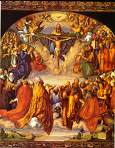
ALL SAINTS, FESTIVAL OF (Festum omnium sanctorum), also formerly known as ALL HALLOWS, or HALLOWMAS, a feast of the Catholic Church celebrated on the 1st of November in honor of all the saints, known or unknown. In the Roman Catholic Church it is a festival of the first rank, with a vigil and an octave. Common commemorations, by several churches, of the deaths of martyrs began to be celebrated in the 4th century. The first trace of a general celebration is in Antioch on the Sunday after Pentecost, and this custom is also referred to in the 74th homily of St Chrysostom (407). The origin of the festival of All Saints as celebrated in the West is, however, somewhat doubtful. In 609 or 610 Pope Boniface IV. consecrated the Pantheon at Rome to the Blessed Virgin and all the martyrs, and the feast of the dedicatio Sanctae Mariae ad Martyres has been celebrated at Rome ever since on the 13th of May. The idea, based on the medieval liturgiologists, that this festival was the origin of that of All Saints has now been abandoned. The latter is possibly traceable to the foundation by Gregory III. (731-741) of an oratory in St Peter’s for the relics “of the holy apostles and of all saints, martyrs and confessors, of all the just made perfect who are at rest throughout the world.” So far as the Western Church generally is concerned, though the festival was already widely celebrated in the days of Charlemagne, it was only made of obligation throughout the Frankish empire in 835 by a decree of Louis the Pious issued “at the instance of Pope Gregory IV. and with the assent of all the bishops,” which fixed its celebration on the 1st of November. The festival was retained at the Reformation in the calendar of the Church of England, and also in that of many of the Lutheran churches. In the latter, in spite of attempts at revival, it has fallen into complete disuse.
Copyright © World Spirituality · All Rights Reserved